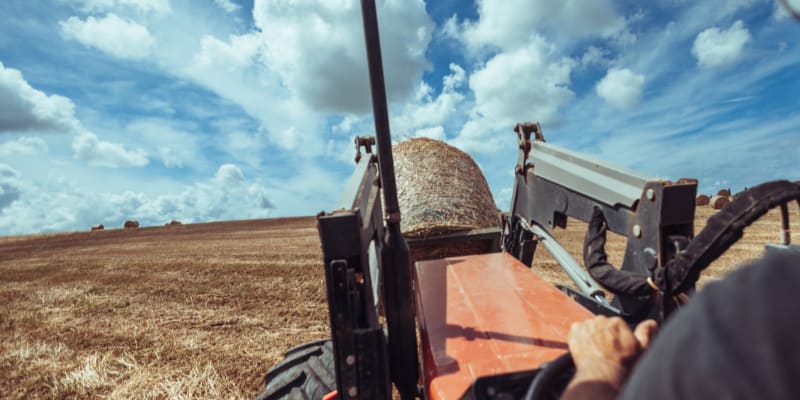Prevent critical injuries by moving material safely: 7 tips for farmers

“Being struck by equipment, material, or livestock continues to be one of the leading causes of injury for farmers,” says Ryan Dick, Health and Safety Consultant with Workplace Safety & Prevention Services (WSPS). “In my experience, using the wrong equipment is often a contributing factor in these incidents.”
Struck-by injuries, when a worker is hit or crushed by equipment, heavy materials, or livestock, can be life-altering or life-ending. When reviewing injury statistics from the Ministry of Labour, Immigration, Training, and Skills Development (MLITSD), Ryan noted the repeated appearance of farmers being struck by hay bales and trees. “A hay bale can weigh anywhere between 1100 and 2200 pounds. If they get wet or baled with high moisture, they can be even heavier. And they are usually packed tightly, which makes them very dense,” describes Ryan. In the same way a large tree can crush a person, if a large hay bale falls on a farmer, it can be fatal.
When heavy equipment, such as front-end loaders, skid steers, or telehandlers, are used to move material like trees, hay, and straw, they expose farm workers to serious risks, particularly because the loads are often not secured. “If you try to move multiple bales loaded on a front-end loader, usually only the bottom bale is secured, if any of them are,” explains Ryan. “If you hit uneven ground, or the load shifts as you move, there is nothing stopping that material from falling.”
Not only does this become a serious hazard for others working in the area, but it is also a hazard for the equipment operator. “If the operator is in an open cab, the load can slide back onto them,” says Ryan. “To protect themselves and their workers, farmers really have to consider whether they are using the best type of equipment for the job.”
The right equipment with the right attachments reduces risk
When moving material on your farm, reduce the risk by avoiding equipment with an open cab. “With several closed-cab options available, there is no reason to expose the operator to the possibility of that load falling and critically injuring them,” says Ryan. A closed cab with heat and air conditioning will also protect the operator from heat-related hazards in the summer and cold-related hazards in the winter. “Closed cabs also reduce sun exposure,” notes Ryan.
When determining which type of equipment is best suited for the job, consider the size and weight of the load, where you are moving it, and how you will secure it. “For example, a telehandler may be a more appropriate and safer option than a front-end loader for loading hay bales onto a tactor-trailer, particularly if you are loading to a height that is higher than the height the tractor can safely raise each bale on its own,” says Ryan. He also recommends considering a grapple attachment. “A grapple is a good choice because it can close tightly around the load and hold it in place. Whether you are moving trees, hay, or straw, your load will not shift the way it could with other attachments,” he says.
7 ways to protect farmers from struck-by injuries
- Secure the load. “Strap all your loads, especially bales and logs,” says Ryan. Unsecured loads can easily become unstable and fall. Use straps of adequate strength and thickness to hold the weight of your load.
- Keep the load low. Do not elevate the load until you are ready to put it onto a truck or trailer. “Until you are about a foot away from the truck, there is no reason to raise the load,” notes Ryan.
- Use a signaller or spotter when backing up. Whether it’s a tractor, skid steer, or another type of vehicle, always have a signaller working with the equipment operator to ensure blind spots are clear, particularly when the implement is wider than the equipment “Most farm equipment does not have a back-up alarm, so a spotter or signaller is an effective way to make sure no one is in the path of the equipment or implement,” explains Ryan.
- Separate pedestrian and equipment traffic. Avoid the hazard of workers colliding with a vehicle or equipment by establishing separate pathways and right-of-way procedures if they must intersect. Plan work so that there is no one working in the area where heavy equipment is operating. “This includes truck and delivery drivers,” says Ryan. “Prohibit drivers from walking near the truck while it is being loaded, have them wait until loading is complete before strapping is started.”
- Wear high-visibility clothing. This will make it easier for equipment operators to see other workers in the field.
- Never place yourself between livestock and a wall or gate. Ensure that you always have a direct route to an exit when working with livestock—especially large animals.
- Have a check-in plan for working alone. It is best to plan the work, so no one is working alone; however, we know there are some tasks that require farm workers to be out in the field on their own in areas that expose them to struck-by injuries. Make sure you have a regular check-in plan and know the exact location of the worker in case you need to find them. “Farmers and workers should always have the civic address of their location in case they have to call 911 in an emergency situation,” recommends Ryan.
The information in this article is accurate as of its publication date.




